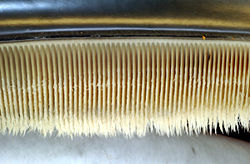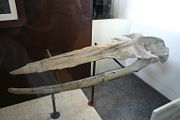Baleen whale

Baleen
The baleen whales, also called whalebone whales or great whales, form the Mysticeti, one of two suborders of the Cetacea (whales, dolphins, and porpoises). Baleen whales are characterized by having baleen plates for filtering food from water, rather than having teeth. This distinguishes them from the other suborder of cetaceans, the toothed whales or Odontoceti. Living Mysticeti species have teeth only during the embryonal phase. Fossil Mysticeti had teeth before baleen evolved.
The suborder contains four families and fourteen species. A list of species can be found below and at the Cetacea article. The scientific name derives from the Greek word mystidos, which means "unknowable".
Anatomy
Baleen whales are generally larger than toothed whales, and females are larger than males. This group includes the largest known animal species, the Blue Whale.
Baleen whales have two blowholes, causing a V-shaped blow.
Ecology and life history
Behavioral ecology
Breaching
In spite of their enormous mass, baleen whales are able to leap completely out of the water. Particularly known for its acrobatics is the Humpback Whale, but other baleen whales also break through the water surface with their body or beat it loudly with their fins. The reason for these habits is not known for certain. Some believe that the male baleen whales try to show off to the females, to increase their mating success.
Importance to humans
From the 11th to the late 20th centuries, baleen whales were hunted commercially for their oil and baleen. Their oil can be made into margarine and cooking oils. Baleen was used to stiffen corsets, as parasol ribs, and to crease paper.
Evolutionary history
- See also: Evolution of Cetaceans

Parietobalaena palmeri skull
Early baleen whales first appeared as far back as Early Oligocene, or perhaps the latest Eocene (39-29 million years ago; E.g. Llanocetus). Early baleen whales possessed teeth inherited from their ancestors, as opposed to baleen, in modern species. The Oligocene species Aetiocetus cotylalveus is considered the evolutionary link between toothed and baleen whales. It was discovered by renowned fossil collector Douglas Emlong in 1964 near Seal Rock State Recreation Site, Oregon in a sandstone formation.[2] In the early 1990s, the species Janjucetus hunderi was discovered in Victoria, Australia by a surfer and was described in 2006 by E. M. G. Fitzgerald.[3] Janjucetus was a baleen whale with sharp teeth that hunted fish and squid as well as larger prey, potentially including sharks and dolphin-like cetaceans. These fossils hint that early baleen whales were predatory and eventually evolved into the gentler, toothless whales known today. A recent study identified palatal foramina (bony impressions of blood vessels that 'feed' the baleen racks) in the palate of a toothed mysticete, Aetiocetus weltoni. The scientists involved indicated that this discovery implies that this whale possessed both teeth and baleen, and serves as an intermediate adaptive role between primitive toothed mysticetes and more advanced toothless mysticetes[4]. The first baleen-bearing, toothless baleen whales (such as Eomysticetus, and Micromysticetus)appeared in the late Oligocene [5]. Early baleen whales probably could not echolocate; no anatomical evidence preserved in the skulls and ear regions of any fossil baleen whales show any of the adaptations associated with echolocation as in 'toothed whales' (Odontoceti) [6].
Taxonomic classification
- Genus Eubalaena
- North Atlantic Right Whale, Eubalaena glacialis
- North Pacific Right Whale, Eubalaena japonica
- Southern Right Whale, Eubalaena australis
- Family Balaenopteridae: Rorquals
- Subfamily Balaenopterinae
- Genus Balaenoptera
- Fin Whale, Balaenoptera physalus
- Sei Whale, Balaenoptera borealis
- Bryde's Whale, Balaenoptera brydei
- Eden's Whale, Balaenoptera edeni
- Blue Whale, Balaenoptera musculus
- Common Minke Whale, Balaenoptera acutorostrata
- Antarctic Minke Whale, Balaenoptera bonaerensis
- Balaenoptera omurai, discovery announced November 2003. No common name yet in usage
- † Genus Eobalaenoptera
- † Eobalaenoptera harrisoni, fossil species first discovered June 2004. No common name.
- Genus Caperea
- Pygmy Right Whale, Caperea marginata
†Extinct
References
- ↑ Mead, James G. and Robert L. Brownell, Jr (November 16 2005). Wilson, D. E., and Reeder, D. M. (eds). ed.. Mammal Species of the World (3rd edition ed.). Johns Hopkins University Press. pp. 723–743. ISBN 0-801-88221-4. http://www.bucknell.edu/msw3/browse.asp?id=14300002.
- ↑ Wallace, D.R. (2007). Neptune's Ark: From Ichthyosaurs to Orcas. Berkeley ; London: University of California Press. ISBN 0-520-24322-6.
- ↑ Fitzgerald, E. M. G. (2006). "A bizarre new toothed mysticete (Cetacea) from Australia and the early evolution of baleen whales". Proceedings of the Royal Society - 'B': Biological Sciences, 273 (1604): 2955–2963. doi:10.1098/rspb.2006.3664.
- ↑ Deméré, T., McGowen, M., Berta, A., Gatesy, J. (2008). Morphological and Molecular Evidence for a Stepwise Evolutionary Transition from Teeth to Baleen in Mysticete Whales. Systematic Biology, 57(1), 15-37
- ↑ A. E. Sanders and L. G. Barnes. 2002. Paleontology of the Late Oligocene Ashley and Chandler Bridge Formations of South Carolina, 3: Eomysticetidae, a new family of primitive mysticetes (Mammalia: Cetacea). Smithsonian Contributions to Paleobiology 93:313-356
- ↑ Fitzgerald, E. M. G. (2006). "A bizarre new toothed mysticete (Cetacea) from Australia and the early evolution of baleen whales". Proceedings of the Royal Society - 'B': Biological Sciences, 273 (1604): 2955–2963. doi:10.1098/rspb.2006.3664.
|
Extant Cetacea species |
|
| Kingdom Animalia · Phylum Chordata · Class Mammalia · Infraclass Eutheria · Superorder Laurasiatheria · (unranked) Cetartiodactyla · (unranked) Whippomorpha |
|
|
Suborder Mysticeti (Baleen whales) |
|
| Balaenidae |
|
|
Balaenopteridae
(Rorquals) |
|
|
| Eschrichtiidae |
|
|
| Neobalaenidae |
|
Caperea
|
Pygmy Right Whale (C. marginata)
|
|
|
|
|
|
Suborder Odontoceti (Toothed whales) (cont. below) |
|
Delphinidae
(Oceanic dolphins) |
|
Peponocephala
|
Melon-headed Whale (P. electra)
|
|
|
|
|
|
|
Feresa
|
Pygmy Killer Whale (F. attenuata)
|
|
|
Pseudorca
|
False Killer Whale (P. crassidens)
|
|
|
|
Long-finned Pilot Whale (G. melas) · Short-finned Pilot Whale (G. macrorhynchus)
|
|
|
|
Long-beaked Common Dolphin (D. capensis) · Short-beaked Common Dolphin (D. delphis)
|
|
|
Lissodelphis
(Right whale dolphins)
|
Northern Right Whale Dolphin (L. borealis) · Southern Right Whale Dolphin (L. peronii)
|
|
|
Sotalia
|
Tucuxi (S. fluviatilis) · Costero (Sotalia guianensis)
|
|
|
Sousa
|
Pacific Humpback Dolphin (S. chinensis) · Indian Humpback Dolphin (S. plumbea) · Atlantic Humpback Dolphin (S. teuszii)
|
|
|
Stenella
|
Atlantic Spotted Dolphin (S. frontalis) · Clymene Dolphin (S. clymene) · Pantropical Spotted Dolphin (S. attenuata) · Spinner Dolphin (S. longirostris) · Striped Dolphin (S. coeruleoalba)
|
|
|
Steno
|
Rough-toothed Dolphin (S. bredanensis)
|
|
|
|
|
|
|
Cephalorhynchus
|
Chilean Dolphin (C. eutropia) · Commerson's Dolphin (C. commersonii) · Heaviside's Dolphin (C. heavisidii) · Hector's Dolphin (C. hectori)
|
|
|
Grampus
|
Risso's Dolphin (G. griseus)
|
|
|
Lagenodelphis
|
Fraser's Dolphin (L. hosei)
|
|
|
Lagenorhynchus
|
Atlantic White-sided Dolphin (L. acutus) · Dusky Dolphin (L. obscurus) · Hourglass Dolphin (L. cruciger) · Pacific White-sided Dolphin (L. obliquidens) · Peale's Dolphin (L. australis) · White-beaked Dolphin (L. albirostris)
|
|
|
Orcaella
|
Irrawaddy Dolphin (O. brevirostris) · Australian Snubfin Dolphin (O. heinsohni)
|
|
|
|
|
|
Suborder Odontoceti (Toothed whales) (cont. above) |
|
| Monodontidae |
|
|
Phocoenidae
(Porpoises) |
|
Neophocaena
|
Finless Porpoise (N. phocaeniodes)
|
|
|
|
Harbor Porpoise (P. phocoena) · Vaquita (P. sinus) · Spectacled Porpoise (P. dioptrica) · Burmeister's Porpoise (P. spinipinnis)
|
|
|
Phocoenoides
|
Dall's Porpoise (P. dalli)
|
|
|
| Physeteridae |
|
|
| Kogiidae |
|
Kogia
|
Pygmy sperm whale (K. breviceps) · Dwarf sperm whale (K. simus)
|
|
|
Ziphidae
(Beaked whales) |
|
Berardius
|
Arnoux's Beaked Whale (B. arnuxii) · Baird's Beaked Whale (B. bairdii)
|
|
|
Hyperoodon
|
Northern Bottlenose Whale (H. ampullatus) · Southern Bottlenose Whale (H. planifrons)
|
|
|
Indopacetus
|
Longman's Beaked Whale (I. pacificus)
|
|
|
Mesoplodon
(Mesoplodont
whales)
|
Sowerby's Beaked Whale (M. bidens) · Andrews' Beaked Whale (M. bowdoini) · Hubbs' Beaked Whale (M. carlhubbsi) · Blainville's Beaked Whale (M. densirostris) · Gervais' Beaked Whale (M. europaeus) · Ginkgo-toothed Beaked Whale (M. ginkgodens) · Gray's Beaked Whale (M. grayi) · Hector's Beaked Whale (M. hectori) · Layard's Beaked Whale (M. layardii) · True's Beaked Whale (M. mirus) · Pygmy Beaked Whale (M. peruvianus) · Perrin's Beaked Whale (M. perrini) · Stejneger's Beaked Whale (M. stejnegeri) · Spade-toothed Whale (M. traversii)
|
|
|
Tasmacetus
|
Shepherd's Beaked Whale (T. sheperdi)
|
|
|
Ziphius
|
Cuvier's Beaked Whale (Z. cavirostris)
|
|
|
| Iniidae |
|
Inia
|
Amazon River Dolphin (I. geoffrensis)
|
|
|
| Lipotidae |
|
|
| Platanistidae |
|
Platanista
|
Ganges and Indus River Dolphin (P. gangetica)
|
|
|
| Pontoporiidae |
|
Pontoporia
|
La Plata Dolphin (P. blainvillei)
|
|
|
|
|


